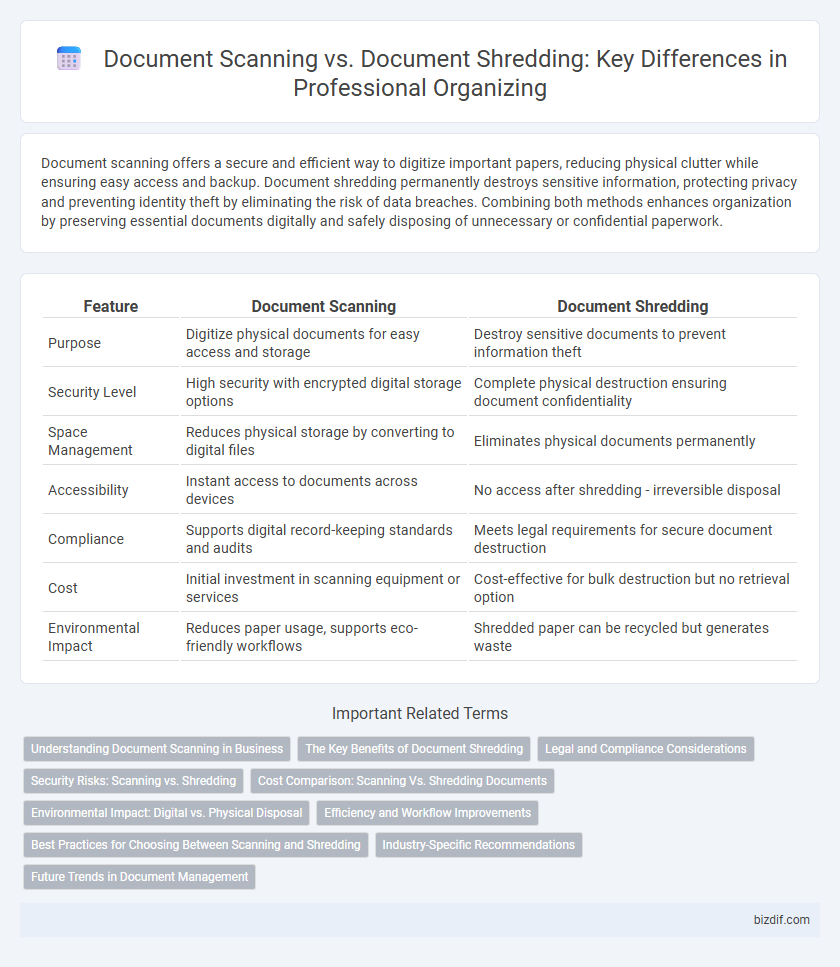Document scanning offers a secure and efficient way to digitize important papers, reducing physical clutter while ensuring easy access and backup. Document shredding permanently destroys sensitive information, protecting privacy and preventing identity theft by eliminating the risk of data breaches. Combining both methods enhances organization by preserving essential documents digitally and safely disposing of unnecessary or confidential paperwork.
Table of Comparison
| Feature | Document Scanning | Document Shredding |
|---|---|---|
| Purpose | Digitize physical documents for easy access and storage | Destroy sensitive documents to prevent information theft |
| Security Level | High security with encrypted digital storage options | Complete physical destruction ensuring document confidentiality |
| Space Management | Reduces physical storage by converting to digital files | Eliminates physical documents permanently |
| Accessibility | Instant access to documents across devices | No access after shredding - irreversible disposal |
| Compliance | Supports digital record-keeping standards and audits | Meets legal requirements for secure document destruction |
| Cost | Initial investment in scanning equipment or services | Cost-effective for bulk destruction but no retrieval option |
| Environmental Impact | Reduces paper usage, supports eco-friendly workflows | Shredded paper can be recycled but generates waste |
Understanding Document Scanning in Business
Document scanning in business transforms physical files into secure digital formats, enabling efficient storage, quick retrieval, and improved workflow. High-resolution scanners capture detailed images, while OCR (Optical Character Recognition) technology converts text for easy editing and searching. By digitizing documents, companies can reduce physical storage costs, enhance data security, and accelerate decision-making processes.
The Key Benefits of Document Shredding
Document shredding ensures the secure destruction of sensitive information, preventing identity theft and data breaches. It supports compliance with privacy laws such as HIPAA and GDPR by eliminating confidential documents beyond recovery. Proper shredding also reduces physical clutter, enhancing workspace organization and promoting environmental responsibility through shredding-based recycling programs.
Legal and Compliance Considerations
Document scanning enhances compliance by creating secure, searchable digital records that meet legal retention requirements and facilitate easy retrieval during audits or litigation. Document shredding is essential for disposing of sensitive physical documents, ensuring adherence to privacy laws such as GDPR and HIPAA by preventing unauthorized access to confidential information. Balancing scanning for preservation and shredding for secure destruction supports robust information governance and minimizes legal risks.
Security Risks: Scanning vs. Shredding
Document scanning reduces physical storage risks by digitizing sensitive information but introduces cybersecurity threats such as data breaches and hacking if not properly encrypted. In contrast, document shredding eliminates the original physical threat by irreversibly destroying hard copies, mitigating risks of identity theft and unauthorized access. Effective professional organizing balances these methods by implementing secure scanning protocols alongside certified shredding services to enhance overall information security.
Cost Comparison: Scanning Vs. Shredding Documents
Document scanning typically involves an initial investment in high-quality scanners and storage solutions, with ongoing costs for digital management software, whereas document shredding incurs expenses primarily related to labor, equipment maintenance, and secure disposal fees. Over time, scanning reduces physical storage costs and can enhance productivity through quicker access to digital files, while shredding continuously consumes resources for safe destruction and landfill fees. Organizations seeking cost efficiency should weigh the long-term savings of digitization against the recurring expenses and environmental considerations of document shredding.
Environmental Impact: Digital vs. Physical Disposal
Document scanning significantly reduces environmental impact by minimizing paper waste, lowering the need for physical storage, and reducing carbon emissions associated with transporting and shredding paper. In contrast, document shredding contributes to deforestation and generates landfill waste unless the shredded paper is recycled efficiently. Transitioning to digital document management supports sustainable office practices by decreasing reliance on physical materials and promoting eco-friendly information retention.
Efficiency and Workflow Improvements
Document scanning streamlines workflow by converting paper files into searchable, digital formats, enabling quick access and reducing physical storage needs. Document shredding, while essential for secure disposal, eliminates clutter but does not enhance document retrieval or collaboration. Integrating scanning with organized digital filing systems significantly boosts efficiency compared to shredding alone.
Best Practices for Choosing Between Scanning and Shredding
Choosing between document scanning and shredding depends on factors such as data sensitivity, space availability, and legal retention requirements. Scanning offers digital backup, easy organization, and quick access, making it ideal for frequently used or long-term records. Shredding ensures secure disposal of confidential materials, reducing clutter and protecting against identity theft when documents are no longer needed or legally required.
Industry-Specific Recommendations
Document scanning preserves important industry-specific records in digital format, enhancing accessibility and compliance with regulations such as HIPAA for healthcare or FINRA for financial services. Document shredding is essential for securely disposing of sensitive materials to prevent data breaches and meet standards like GDPR or FACTA. Tailoring these practices to the unique requirements of each industry ensures both efficient document management and legal protection.
Future Trends in Document Management
Future trends in document management emphasize the integration of advanced document scanning technologies with secure cloud storage, enabling easier access and enhanced data analytics. Automated shredding solutions are evolving to support compliance with increasingly stringent data privacy regulations, ensuring secure disposal of sensitive information. Organizations are prioritizing hybrid approaches that balance digital transformation with robust physical document destruction to optimize security and efficiency.
document scanning vs document shredding Infographic

 bizdif.com
bizdif.com